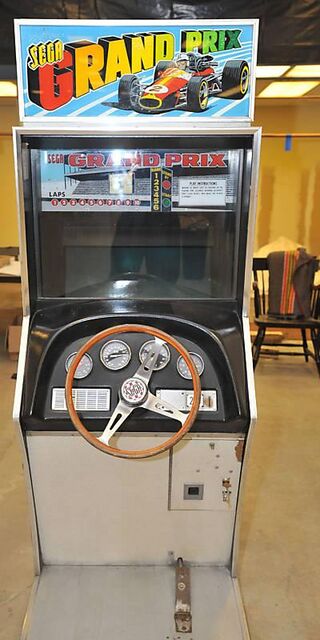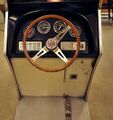Grand Prix
From Sega Retro
| Grand Prix | |||||
|---|---|---|---|---|---|
| System(s): Electro-mechanical | |||||
| Publisher: Sega | |||||
| Developer: Sega | |||||
| Genre: Racing | |||||
| Number of players: 1 | |||||
|
Grand Prix is a 1969 electro-mechanical arcade racing game produced by Sega. The player has control of a racing car in competition and can speed up or slow down by using the gas pedal at the cabinet's base. The object is to avoid and pass other cars without colliding into them. Collisions are accompanied by a crash sound and impact movement by the steering wheel.
It was a video projection game, with a a first-person view and forward-scrolling road projected on a screen. It also had electronic sound, and a dashboard with a racing wheel and accelerator. It is largely based on the earlier video projection game Indy 500, with the gameplay and projection being based on the earlier racing game Indy 500, released by Kasco (Kansai Seiki Seisakusho Co.) in early 1969. Its projection display system is also similar to Sega's Duck Hunt, Missile, Jet Rocket and Killer Shark.
History
The electro-mechanical golden age began with the 1959 arcade hit Mini Drive, a racing game where the player used a steering wheel to control a miniature car across a scrolling conveyor belt inside an arcade cabinet. It was manufactured by Kasco (Kansei Seiki Seisakusho) and became a hit in Japan.[1]
In the late 1960s, Japanese arcade manufacturers Kasco and Sega introduced a new type of electro-mechanical game, video projection games. They looked and played like later arcade video games, but relied on electro-mechanical components to produce sounds and images rather than a CRT display. They used rear video image projection to display moving animations on a video screen.[2][1][3] Video projection games became common in arcades of the 1970s. They combined electro-mechanical and video elements, laying the foundations for arcade video games, which adapted cabinet designs and gameplay mechanics from earlier video projection games.[3] They also ocassionally used solid-state electronics for sounds (like Grand Prix, Missile and Night Rider).
The first video projection games were Kasco's Indy 500, released in the late 1960s,[1] and Sega's Duck Hunt, released in 1968.[4][5][6]
Kasco's Indy 500 was a rear-projection driving/racing game designed by Kenzou Furukawa. It used rear image projection to display a first-person scrolling track on a video screen, along with rival cars the player needs to avoid crashing into, while the controls consisted of a steering wheel and accelerator pedal. It became a hit in Japan, selling 2,000 cabinets there, and inspired several clones in 1969, including Sega's Grand Prix and Chicago Coin's Speedway, which became an even bigger hit in North America, selling 10,000 cabinets there and winning a prize.[1] Sega's clone Grand Prix also had a first-person view, electronic sound, a dashboard with a racing wheel and accelerator,[7] and a similar forward-scrolling road projected on a screen.[8] Indy 500, and its clones Grand Prix and Speedway, laid the foundations for racing video games.[1]
Specifications
- Height: 65"
- Width: 29"
- Depth: 34"
Gallery
Promotional material
- ↑ 1.0 1.1 1.2 1.3 1.4 Kasco and the Electro-Mechanical Golden Age (Interview), Classic Videogame Station ODYSSEY, 2001
- ↑ Killer Shark: The Undersea Horror Arcade Game from Jaws, D.S. Cohen, About.com
- ↑ 3.0 3.1 Once Upon a Time on the Screen: Wild West in Computer and Video Games, Academia
- ↑ Billboard (December 28, 1968), page 33)
- ↑ SEGA Duck Hunt (Arcade Flyer)
- ↑ Duck Hunt (1969)
- ↑ Grand Prix
- ↑ [Bill Loguidice & Matt Barton (2009), Vintage games: an insider look at the history of Grand Theft Auto, Super Mario, and the most influential games of all time, p. 198, Focal Press, ISBN 0-240-81146-1 Bill Loguidice & Matt Barton (2009), Vintage games: an insider look at the history of Grand Theft Auto, Super Mario, and the most influential games of all time, p. 198, Focal Press, ISBN 0-240-81146-1]





